The Effect of Varying Parameters of Laser Surface Alloying Post-Treatment on the Microstructure and Hardness of Additively Manufactured 17-4PH Stainless Steel
Abstract
1. Introduction
2. Materials and Methods
2.1. Material and Sample Manufacturing
2.2. Laser Surface Alloying
2.3. Characterization of the Samples
3. Results and Discussion
3.1. General Characterisation of the Laser-Affected Zone
3.2. Microstructure Characterization of the Samples That Were Alloyed Using a 1 mm Laser Beam Spot Diameter
3.3. Microstructure Characterization of the Samples That Were Alloyed Using a 1.5 mm Laser Beam Spot Diameter
3.4. Distribution of Boron and Nitrogen
3.5. Microhardness Measurements
4. Conclusions
- The final microstructure developed in the LMZ is dependent on a variety of processing parameters that primarily influence the morphology and orientation of eutectic dendrites in the LMZ during laser surface alloying.
- It was metallographically proven that a fully eutectic microstructure, except for one sample, was developed in the LMZ in the studied samples. According to the AES analysis, the eutectic is formed by chromium–iron-rich boride (containing boron in the range of 27–29 at.%) and the α-iron solid solution supersaturated with boron.
- In the microstructure of the 1.5/600 sample, alongside eutectics, about 40% of α-iron solid solution dendrites were revealed. It was assumed that under the conditions when the laser power density was lower (due to larger laser beam spot diameter), the highest laser scan speed, i.e., 600 mm/min, could support the formation of the supersaturated α-iron solid solution to the detriment of eutectics.
- The results of WDS and AES confirmed alloying the LMZ with nitrogen from the air at a permanent flow in compressed air to the beam interaction zone. This finding may be of overriding importance for industrial practice.
- The formation of the boron eutectic and the supersaturation of the α-iron solid solution with boron and nitrogen (as a part of the eutectic mixture) led to the enhanced microhardness in the LMZ, which was significantly higher compared with that of the heat-treated substrate in the entire range of the used laser spot diameters and laser scan speeds (545.8 ± 12.59–804.7 ± 19.4 vs. 276.8 ± 10.1–312.7 ± 11.7 HV0.1).
Author Contributions
Funding
Data Availability Statement
Acknowledgments
Conflicts of Interest
References
- Gelin, F.D.; Chaus, A.S. Metallic Materials; Vysheishaya Shkola: Minsk, Belarus, 2007. (In Russian) [Google Scholar]
- Douthett, J. Heat Treating of Stainless Steels; Handbook; ASM International: Almere, The Netherlands, 1991; Volume 4, pp. 1681–1757. [Google Scholar]
- Riazi, H.; Ashrafizadeh, F.; Hosseini, S.R.; Ghomashchi, R. Influence of simultaneous aging and plasma nitriding on fatigue performance of 17-4 PH stainless steel. Mater. Sci. Eng. A 2017, 703, 262–269. [Google Scholar] [CrossRef]
- Bajaj, P.; Hariharan, A.; Kini, A.; Kürnsteiner, P.; Raabe, D.; Jägle, E.A. Steels in additive manufacturing: A review of their microstructure and properties. Mater. Sci. Eng. A 2020, 772, 138633. [Google Scholar] [CrossRef]
- Washko, S.D.; Aggen, G. Wrought Stainless Steels; Handbook; ASM International: Almere, The Netherlands, 1990; Volume 1, pp. 1303–1408. [Google Scholar]
- Yan, M.F.; Liu, R.L.; Wu, D.L. Improving the mechanical properties of 17-4PH stainless steel by low temperature plasma surface treatment. Mater. Des. 2010, 31, 2270–2273. [Google Scholar] [CrossRef]
- Yan, M.F.; Liu, R.L. Influence of process time on microstructure and properties of 17-4PH steel plasma nitrocarburized with rare earths addition at low temperature. Appl. Surf. Sci. 2010, 256, 6065–6071. [Google Scholar] [CrossRef]
- Liu, D.; Liu, D.; Zhang, X.; Liu, C.; Ao, N. Surface nanocrystallization of 17-4 precipitation-hardening stainless steel subjected to ultrasonic surface rolling process. Mater. Sci. Eng. A 2018, 726, 69–81. [Google Scholar] [CrossRef]
- Zhang, Q.; Hu, Z.; Su, W.; Zhou, H.; Liu, C.; Yang, Y.; Qi, X. Microstructure and surface properties of 17-4PH stainless steel by ultrasonic surface rolling technology. Surf. Coat. Technol. 2017, 321, 64–73. [Google Scholar] [CrossRef]
- Giouse, J.-B.; White, K.; Tromas, C. Nanoindentation characterization of the surface mechanical properties of a 17-4PH stainless steel substrate treated with grit blasting and coated with a Cr3C2-NiCr coating. Surf. Coat. Technol. 2019, 368, 119–125. [Google Scholar] [CrossRef]
- Deng, D.W.; Zhang, C.P.; Chen, R.; Xia, H.F. Microstructure and microhardness of 17-4PH deposited with Co-based alloy hardfacing coating. Phys. Procedia 2013, 50, 177–184. [Google Scholar] [CrossRef]
- Przestacki, D.; Bartkowska, A.; Kukliński, M.; Kieruj, P. The Effects of laser surface modification on the microstructure of 1.4550 stainless steel. MATEC Web Conf. 2018, 237, 02009. [Google Scholar] [CrossRef][Green Version]
- Chen, Z.; Zhou, G.; Chen, Z. Microstructure and hardness investigation of 17-4PH stainless steel by laser quenching. Mater. Sci. Eng. A 2012, 534, 536–541. [Google Scholar] [CrossRef]
- Yao, J.; Wang, L.; Zhang, Q.; Kong, F.; Lou, C.; Chen, Z. Surface laser alloying of 17-4PH stainless steel steam turbine blades. Opt. Laser Technol. 2008, 40, 838–843. [Google Scholar] [CrossRef]
- Adeyemi, A.A.; Akinlabi, E.T.; Mahamood, R.M.; Sanusi, K.O.; Pityana, S.; Tlotleng, M. Influence of laser power on microstructure of laser metal deposited 17-4 ph stainless steel. IOP Conf. Ser. Mater. Sci. Eng. 2017, 225, 012028. [Google Scholar] [CrossRef]
- Kulka, M.; Mikołajczak, D.; Dziarski, P.; Panfil-Pryka, D. Laser surface alloying of austenitic 316L steel with boron and some metallic elements: Properties. Materials 2021, 14, 2987. [Google Scholar] [CrossRef] [PubMed]
- Kulka, M.; Mikolajczak, D.; Makuch, N.; Dziarski, P.; Miklaszewski, A. Wear resistance improvement of austenitic 316L steel by laser alloying with boron. Surf. Coat. Technol. 2016, 291, 292–313. [Google Scholar] [CrossRef]
- Kulka, M.; Makuch, N.; Pertek, A. Microstructure and properties of laser-borided 41Cr4 steel. Opt. Laser Technol. 2013, 45, 308–318. [Google Scholar] [CrossRef]
- Bartkowski, D.; Bartkowska, A.; Popławski, M.; Przestacki, D. Microstructure, microhardness, corrosion and wear resistance of B, Si and B-Si coatings produced on C45 steel using laser processing. Metals 2020, 10, 792. [Google Scholar] [CrossRef]
- Bartkowska, A.; Bartkowski, D.; Przestacki, D.; Hajkowski, J.; Miklaszewski, A. Microstructural and mechanical properties of B-Cr coatings formed on 145Cr6 tool steel by laser remelting of diffusion borochromized layer using diode laser. Coatings 2021, 11, 608. [Google Scholar] [CrossRef]
- Bartkowska, A.; Jurči, P.; Hudáková, M.; Bartkowski, D.; Kusý, M.; Przestacki, D. The influence of the laser beam fluence on change in microstructure, microhardness and phase composition of FeB-Fe2B surface layer produced on Vanadis-6 steel. Arch. Metall. Mater. 2018, 63, 791–800. [Google Scholar] [CrossRef]
- Bartkowska, A.; Bartkowski, D.; Swadźba, R.; Przestacki, D.; Miklaszewski, A. Microstructure, chemical composition, wear, and corrosionresistance of FeB-Fe2B-Fe3B surface layers produced on Vanadis-6 steel using CO2 laser. Int. J. Adv. Manuf. Technol. 2018, 95, 1763–1776. [Google Scholar] [CrossRef]
- Kuklinski, M.; Bartkowska, A.; Przestacki, D. Laser alloying monel 400 with amorphous boron to obtain hard coatings. Materials 2019, 12, 3494. [Google Scholar] [CrossRef]
- Kuklinski, M.; Bartkowska, A.; Przestacki, D.; Kinal, G. Influence of microstructure and chemical composition on microhardness and wear properties of laser borided Monel 400. Materials 2020, 13, 5757. [Google Scholar] [CrossRef] [PubMed]
- Zhang, F.; Stoudt, M.R.; Hammadi, S.; Campbell, C.E.; Lass, E.A.; Williams, M.E. How austenitic is a martensitic steel produced by laser powder bed fusion? A cautionary tale. Metals 2021, 11, 1924. [Google Scholar] [CrossRef]
- Eskandari, H.; Lashgari, H.R.; Ye, L.; Eizadjou, M.; Wang, H. Microstructural characterization and mechanical properties of additively manufactured 17–4PH stainless steel. Mater. Today Commun. 2022, 30, 103075. [Google Scholar] [CrossRef]
- Shi, Q.; Qin, F.; Li, K.; Liu, X.; Zhou, G. Effect of hot isostatic pressing on the microstructure and mechanical properties of 17-4PH stainless steel parts fabricated by selective laser melting. Mater. Sci. Eng. A 2021, 810, 141035. [Google Scholar] [CrossRef]
- Sun, Y.; Hebert, R.J.; Aindow, M. Effect of heat treatments on microstructural evolution of additively manufactured and wrought 17-4PH stainless steel. Mater. Des. 2018, 156, 429–440. [Google Scholar] [CrossRef]
- Hu, Z.; Zhu, H.; Zhang, H.; Zeng, X. Experimental investigation on selective laser melting of 17-4PH stainless steel. Opt. Laser Technol. 2017, 87, 17–25. [Google Scholar] [CrossRef]
- Gonzalez-Gutierrez, J.; Arbeiter, F.; Schlauf, T.; Kukla, C.; Holzer, C. Tensile properties of sintered 17-4PH stainless steel fabricated by material extrusion additive manufacturing. Mater. Lett. 2019, 248, 165–168. [Google Scholar] [CrossRef]
- Yang, K.T.; Kim, M.K.; Kim, D.; Suhr, J. Investigation of laser powder bed fusion manufacturing and post-processing for surface quality of as-built 17-4PH stainless steel. Surf. Coat. Technol. 2021, 422, 127492. [Google Scholar] [CrossRef]
- Chemkhi, M.; Marae Djouda, J.; Bouaziz, M.A.; Kauffmann, J.; Hild, F.; Retraint, D. Effects of mechanical post-treatments on additively manufactured 17-4PH stainless steel produced by bound powder extrusion. Procedia CIRP 2021, 104, 957–961. [Google Scholar] [CrossRef]
- Bouaziz, M.A.; Marae Djouda, J.; Chemkhi, M.; Rambaudon, M.; Kauffmann, J.; Hild, F. Heat treatment effect of 17-4PH stainless steel manufactured by Atomic Diffusion Additive Manufacturing (ADAM). Procedia CIRP 2021, 104, 935–938. [Google Scholar] [CrossRef]
- Emminghaus, N.; Hoff, C.; Hermsdorf, J.; Kaierle, S. Residual oxygen content and powder recycling: Effects on surface roughness and porosity of additively manufactured Ti-6Al-4V. Addit. Manuf. 2021, 46, 102093. [Google Scholar] [CrossRef]
- Chaus, A.S.; Devoino, O.G.; Sahul, M.; Vančo, Ľ.; Buranský, I.; Kusý, M. Effect of surface roughness on laser surface alloying of additively manufactured 17-4PH stainless steel. Surf. Coat. Technol. 2023, 454, 129161. [Google Scholar] [CrossRef]
- Siddiqui, A.A.; Dubey, A.K. Optimization of geometrical and mechanical characteristics in laser surface alloying. Mater. Today Proc. 2021, 44, 1108–1110. [Google Scholar] [CrossRef]
- Saltykov, S.A. Stereometric Metallography; Metallurgiya: Moscow, Russia, 1970. [Google Scholar]
- Derimow, N.; Schwalbach, E.J.; Benzing, J.T.; Killgore, J.P.; Artusio-Glimpsec, A.B.; Hrabe, N.; Simonds, B.J. In situ absorption synchrotron measurements, predictive modeling, microstructural analysis, and scanning probe measurements of laser melted Ti-6Al-4V single tracks for additive manufacturing applications. J. Alloys Compd. 2022, 900, 163494. [Google Scholar] [CrossRef]
- Higashi, M.; Ozaki, T.; Moronaga, T.; Hara, T.; Osada, T.; Kawagishi, K. Microstructural characteristics of laser surface melted MoSiBTiC alloy. Mater. Lett. 2020, 278, 128465. [Google Scholar] [CrossRef]
- Devojno, O.G.; Feldshtein, E.; Kardapolava, M.A.; Lutsko, N.I. On the formation features; structure, microhardness and tribological behavior of single tracks and coating layers formed by laser cladding of Al- Fe powder bronze. Surf. Coat. Technol. 2019, 358, 195–206. [Google Scholar] [CrossRef]
- Chaus, A.S.; Maksimenko, A.V.; Fedosenko, N.N.; Ćaplovič, Ľ.; Myshkovets, V.N. Formation of structure of a high-speed steel upon laser surface melting. Phys. Met. Metallogr. 2019, 120, 269–277. [Google Scholar] [CrossRef]
- Chaurasia, J.K.; Jinoop, A.N.; Parthasarathy, P.; Paul, C.P.; Bindra, K.S.; Bontha, S. Study of melt pool geometry and solidi cation microstructure during laser surface melting of Inconel 625 alloy. Optik 2021, 246, 167766. [Google Scholar] [CrossRef]
- Leech, P.W. Laser surface melting of a complex high alloy steel. Mater. Des. 2014, 54, 539–543. [Google Scholar] [CrossRef]
- Chaus, A.S.; Maksimenko, A.V.; Fedosenko, N.N.; Ćaplovič, Ľ.; Myshkovets, V.N. Formation of structure of an annealed high-speed steel upon laser surface melting. Phys. Met. Metallogr. 2019, 120, 371–377. [Google Scholar] [CrossRef]
- Krakhmalev, P.; Yadroitsev, I. Microstructure and properties of intermetallic composite coatings fabricated by selective laser melting of TieSiC powder mixtures. Intermetallics 2014, 46, 147–155. [Google Scholar] [CrossRef]
- Sun, G.; Zhou, R.; Li, P.; Feng, A.; Zhang, Y. Laser surface alloying of C-B-W-Cr powders on nodular cast iron rolls. Surf. Coat. Technol. 2011, 205, 2747–2754. [Google Scholar] [CrossRef]
- Monisha, K.; Shariff, S.M.; Sekar, A.; Raju, R.; Manonmani, J.; Senthilselvan, J. Titanium boride coating by high power diode laser alloying of amorphous boron with titanium and its surface property investigations. Opt. Laser Technol. 2024, 170, 110159. [Google Scholar] [CrossRef]
- Zhou, R.; Sun, G. Laser alloying with Mn + Cr3C2 and Mn + NiCr-C for improved wear and corrosion resistance of stainless steel. Surf. Coat. Technol. 2022, 451, 129076. [Google Scholar] [CrossRef]
- Aveson, J.; Reinhart, G.; Goddard, C.; Nguyen-Thi, H.; Mangelinck-Noėl, N.; Tandjaoui, A.; Davenport, J.; Warnken, N.; Di Gioacchino, F.; Laord, T. On the deformation of dendrites during directional solidification of a nickel-based superalloy. Metall. Mater. Trans. A 2019, 50, 5234–5241. [Google Scholar] [CrossRef]
- Labunets, V.F. Laser treatment of rubbing surfaces of machine parts and tools. Bull. Kyiv Int. Univ. Civ. Aviat. 1998, 1, 72–76. (In Russian) [Google Scholar]
- Chaus, A.S.; Pokorný, P.; Čaplovič, Ľ.; Sitkevich, M.V.; Peterka, J. Complex fine-scale diffusion coating formed at low temperature on high-speed steel substrate. Appl. Surf. Sci. 2018, 437, 257–270. [Google Scholar] [CrossRef]
- Chaus, A.S.; Sitkevich, M.V.; Pokorný, P.; Sahul, M.; Haršáni, M.; Babincová, P. Wear resistance and cutting performance of high-speed steel ball nose end mills related to the initial state of tool surface. Wear 2021, 472–473, 203711. [Google Scholar] [CrossRef]
- Li, J.; Chen, B.; Wang, M.; Jing, C.; Fan, Z.; Zhang, Z.; Li, Y.; Zhang, C. Microstructure performance and nano-effect of laser alloying composites with multi-phase on TA1 titanium alloy. Opt. Laser Technol. 2024, 169, 109975. [Google Scholar] [CrossRef]
- Chaus, A.S.; Sahul, M.; Moravčík, R.; Sobota, R. Role of microstructural factor in wear resistance and cutting performance of high-speed steel end mills. Wear 2021, 474–475, 203865. [Google Scholar] [CrossRef]
- Chaus, A.S. Microstructural and properties evaluation of M2 high speed steel after inoculating addition of powder W and WC. Mater. Sci. Technol. 2014, 30, 1105–1115. [Google Scholar] [CrossRef]
- Chaus, A.S.; Rudnitskii, F.I.; Murgas, M. Structural inheritance and special features of fracture of high-speed steels. Met. Sci. Heat Treat. 1997, 39, 53–56. [Google Scholar] [CrossRef]
- Chaus, A.S. Application of bismuth for solidification structure refinement and properties enhancement in as–cast high–speed steels. ISIJ Int. 2005, 45, 1297–1306. [Google Scholar] [CrossRef]


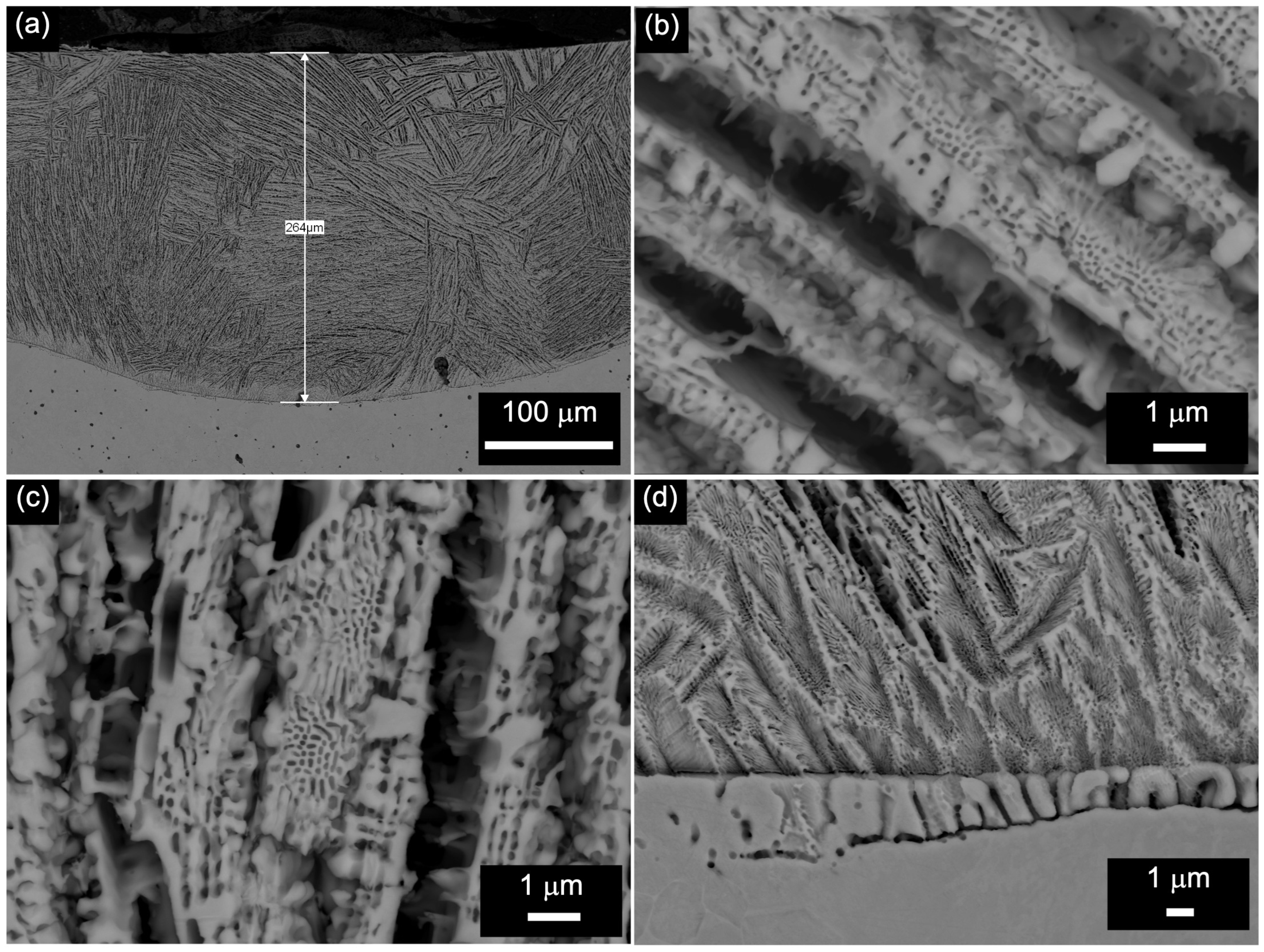

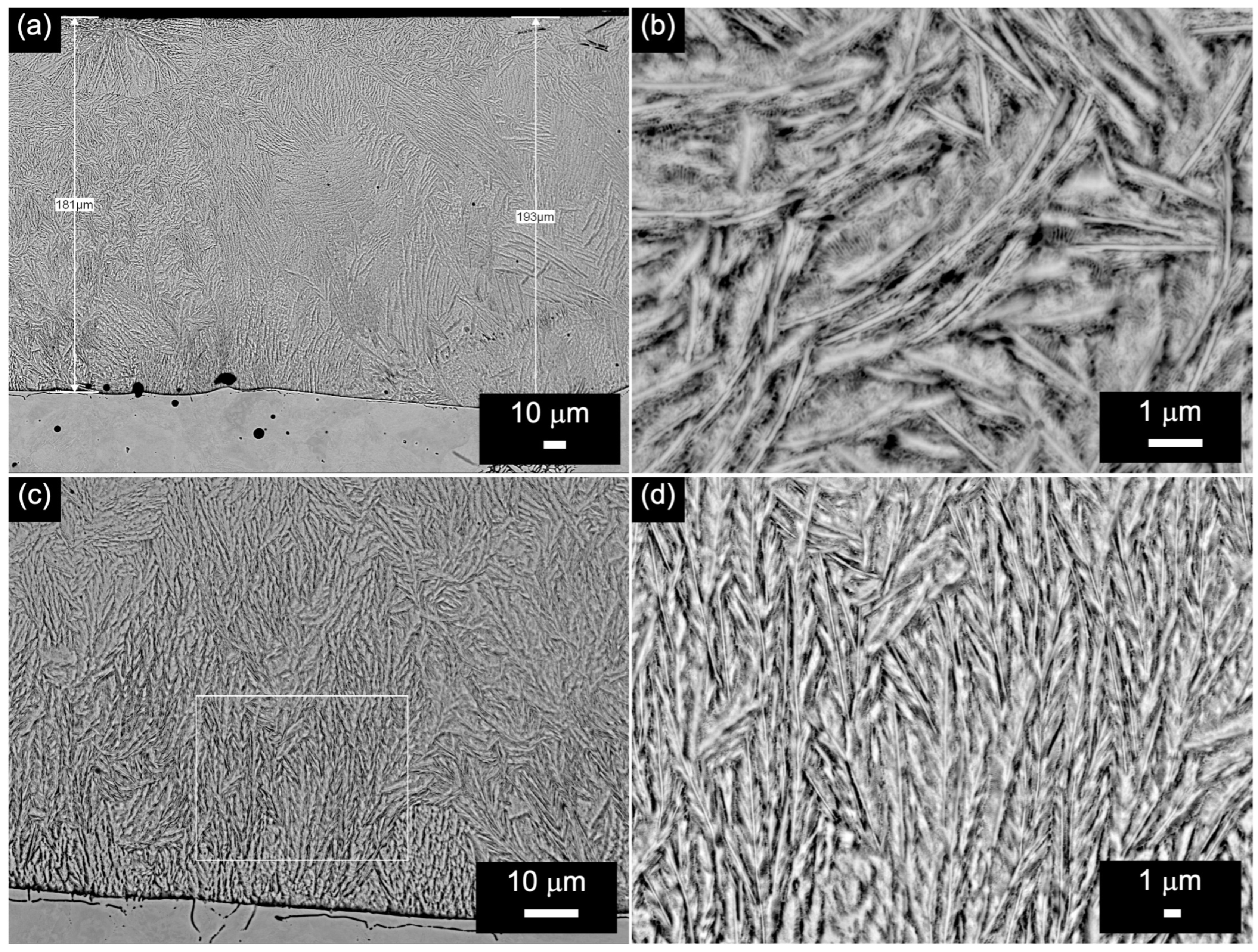
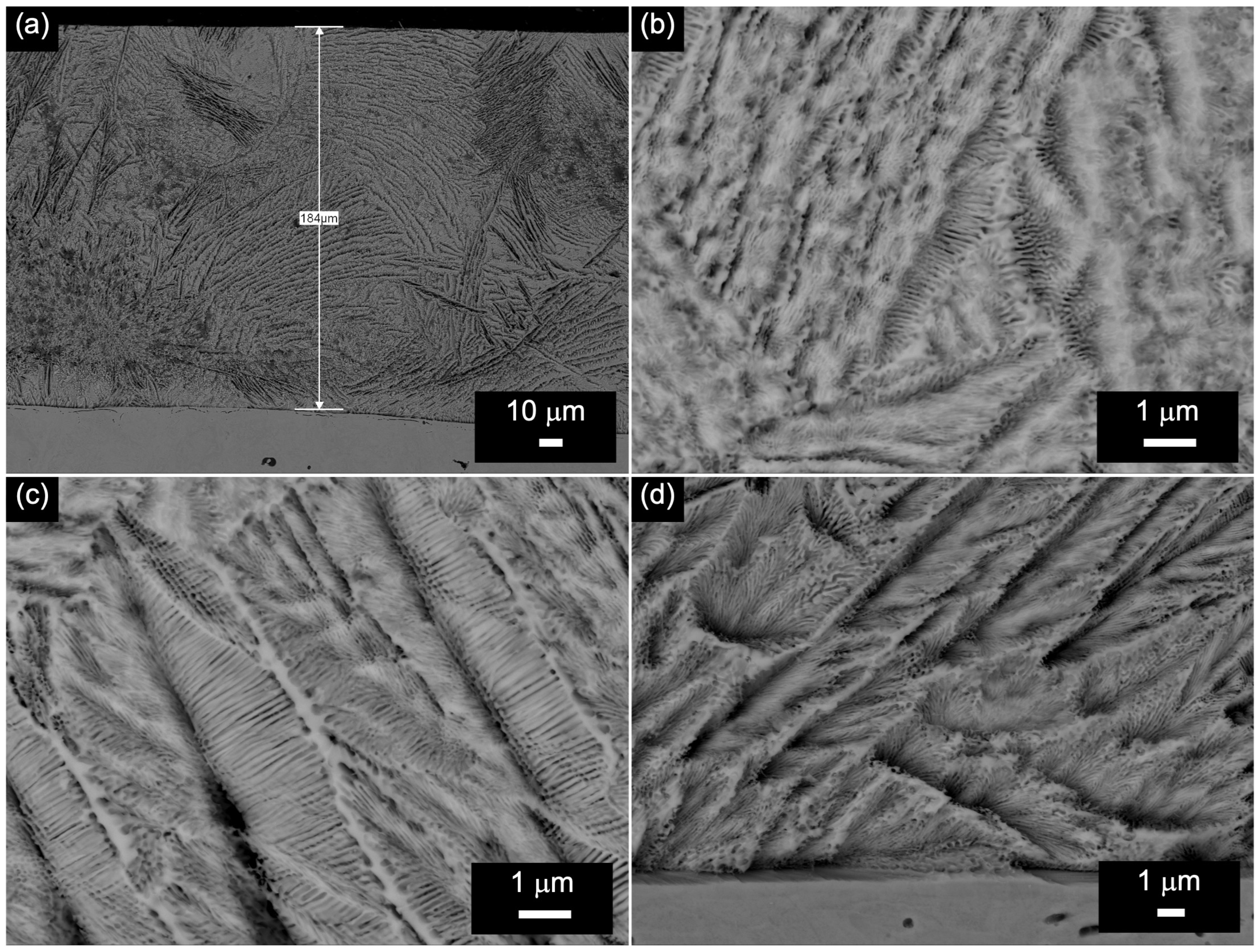
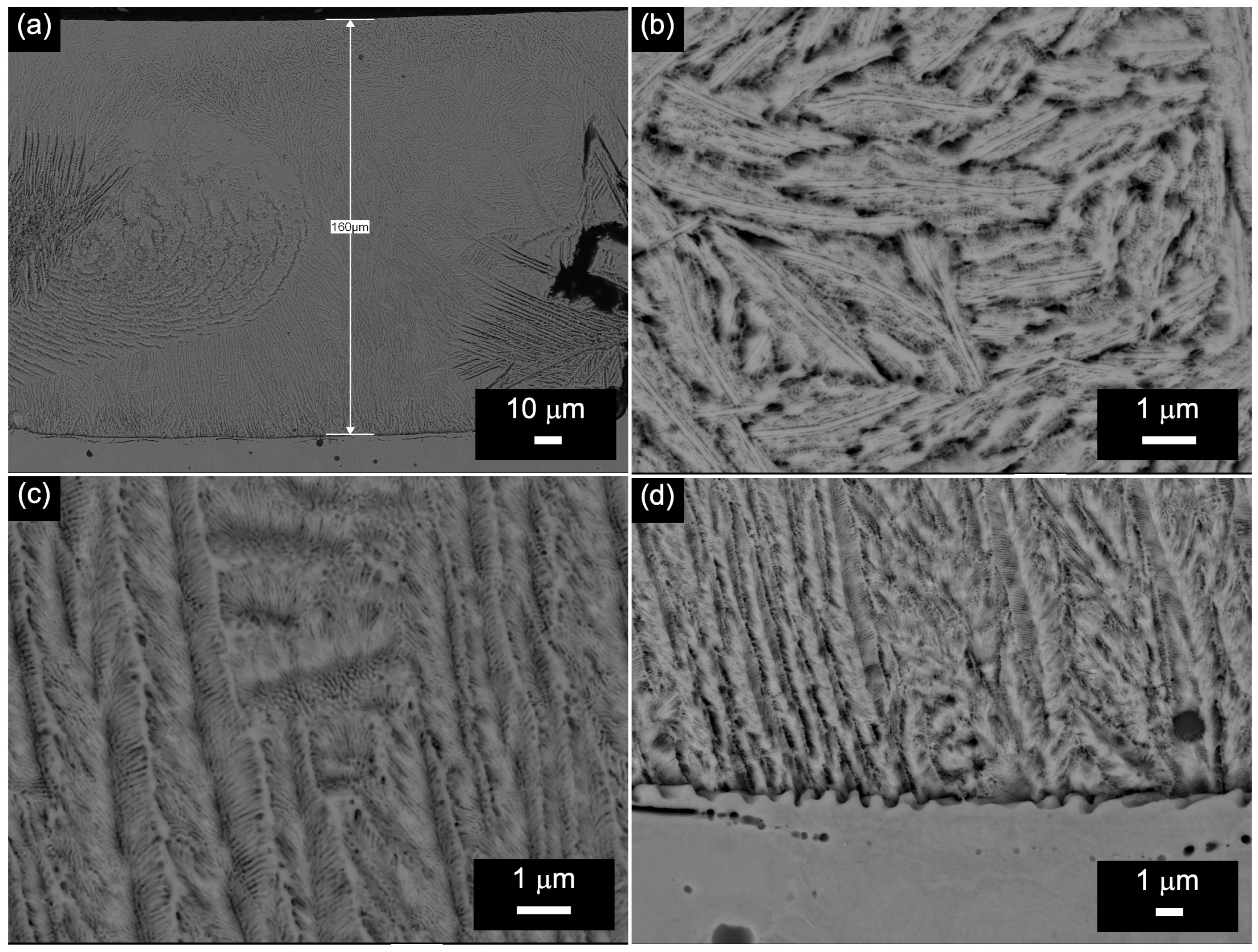


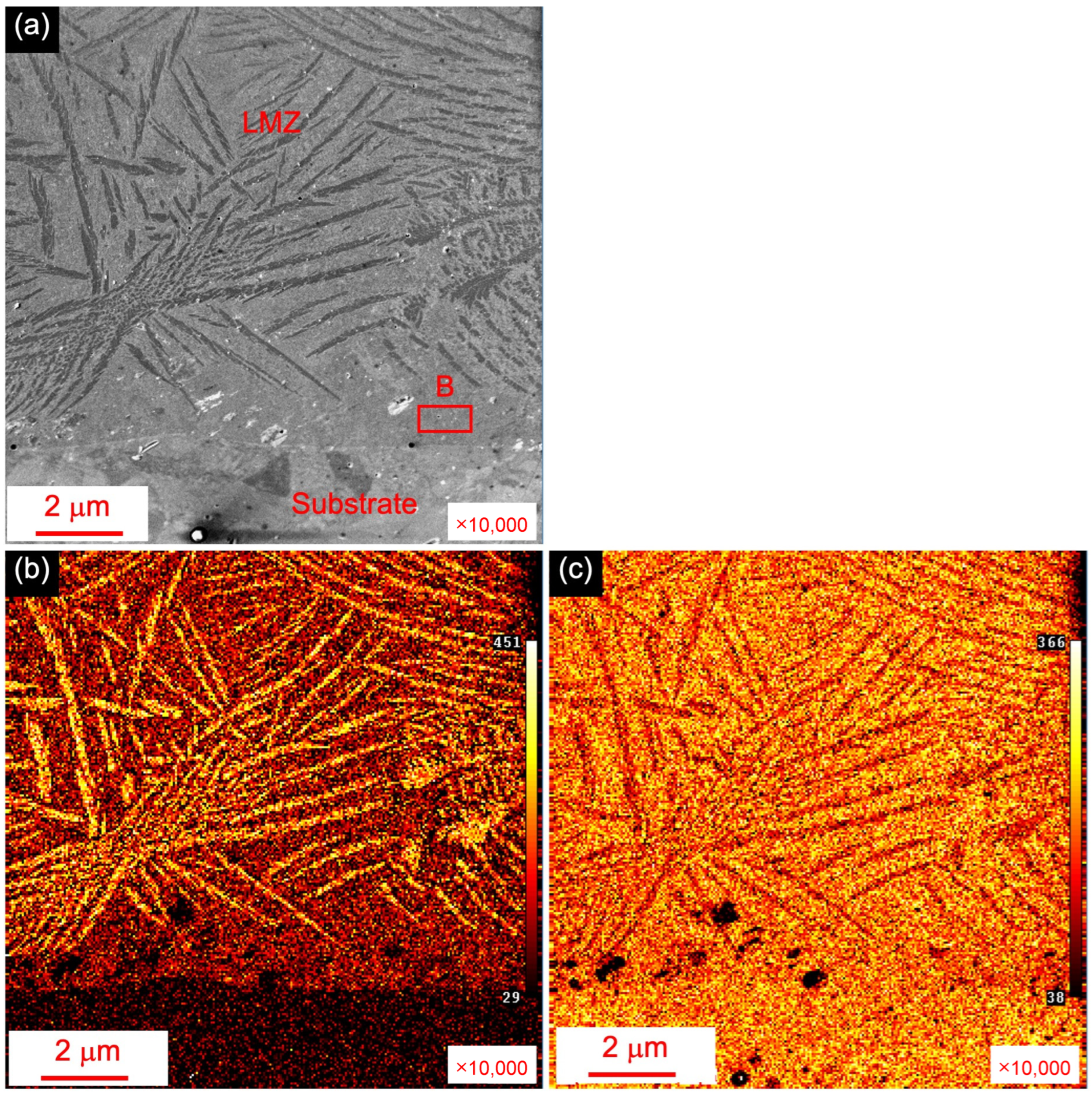
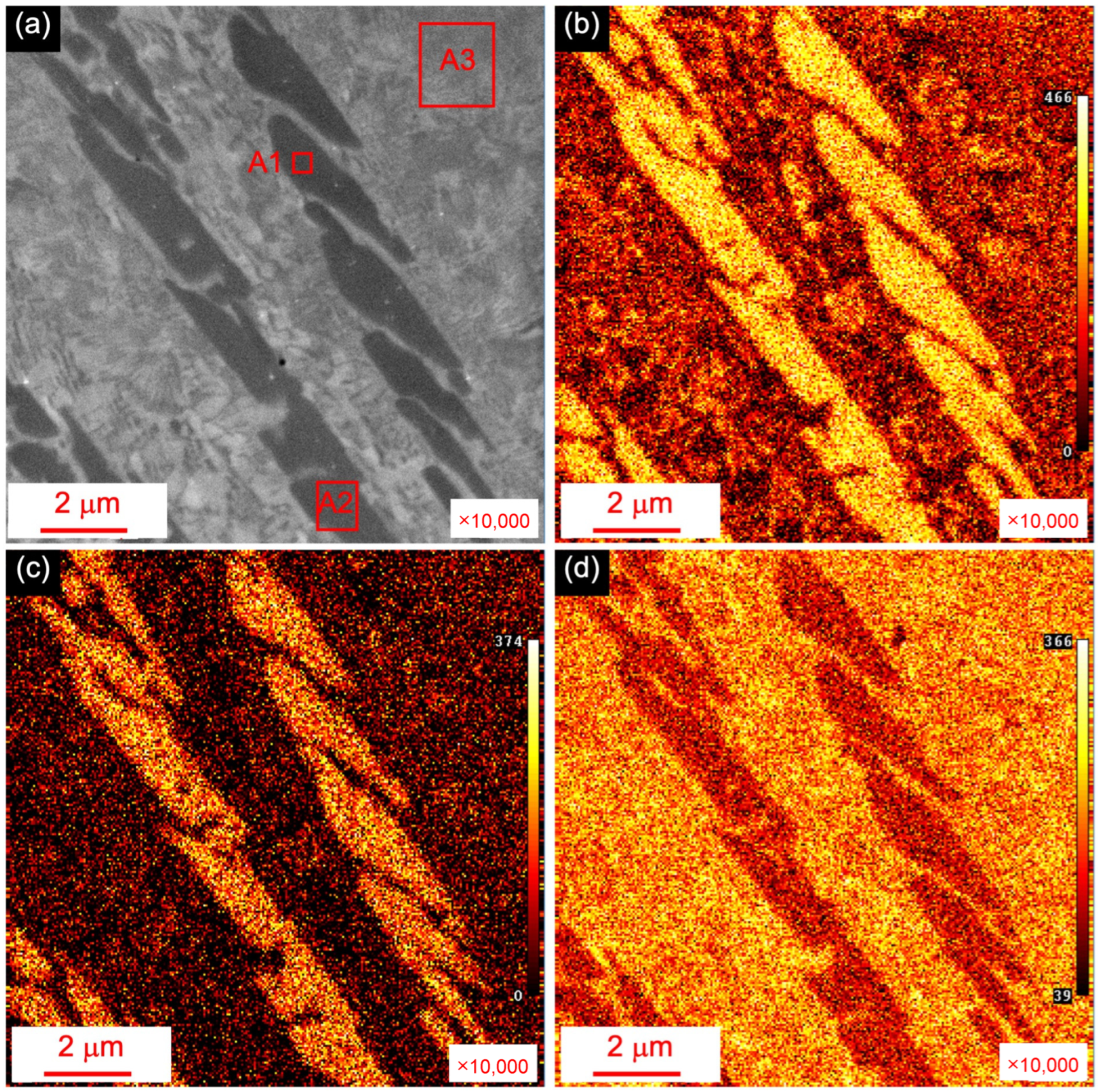
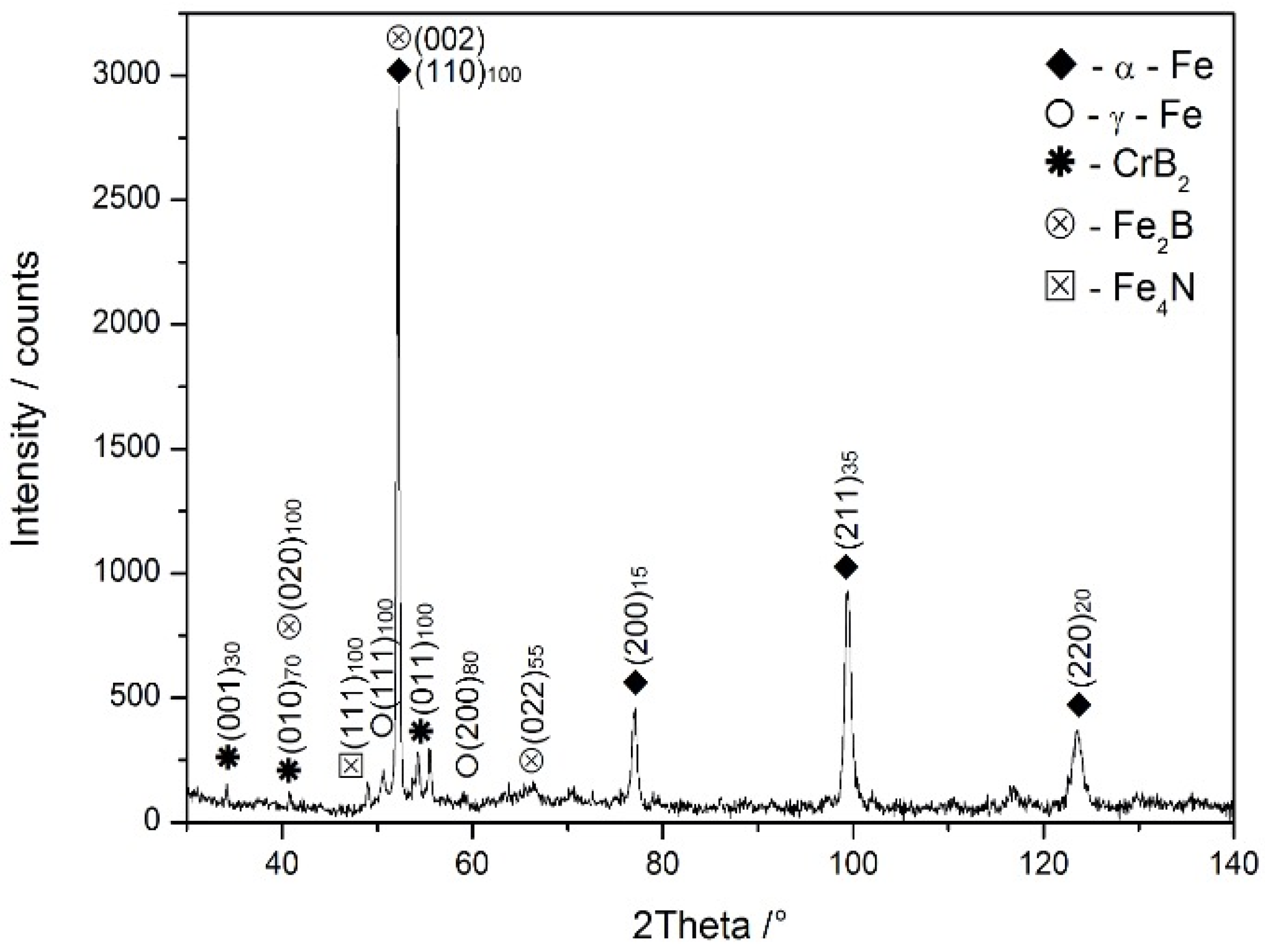
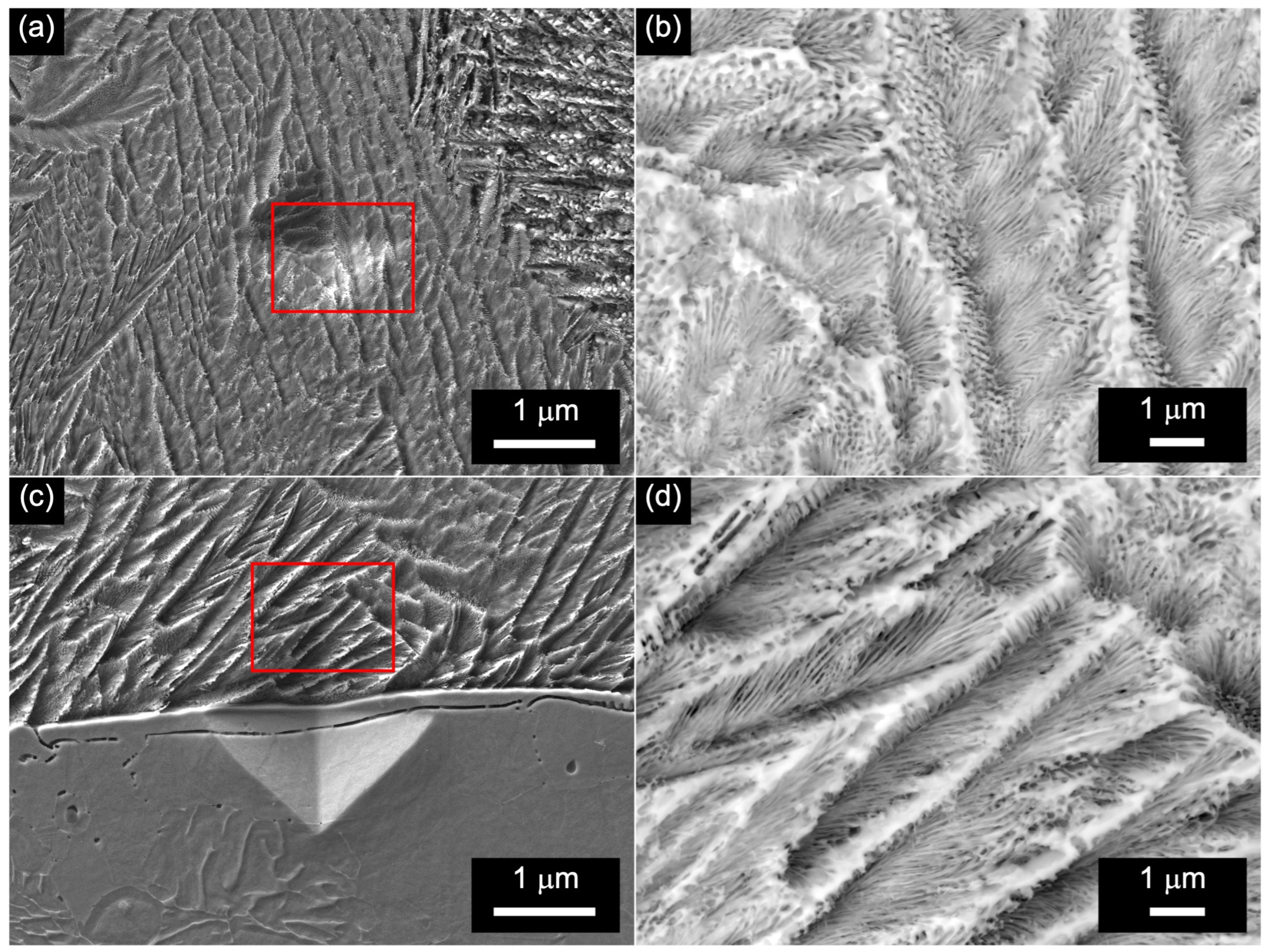
| Sample | 1/200 | 1/400 | 1/600 | 1.5/200 | 1.5/400 | 1.5/600 |
|---|---|---|---|---|---|---|
| Thickness | 262 ± 19.8 | 199 ± 16.5 | 176 ± 16.0 | 242 ± 19.2 | 184 ± 14.7 | 160 ± 12.2 |
| Sample | 1/200 | 1/400 | 1/600 | 1.5/200 | 1.5/400 | 1.5/600 |
|---|---|---|---|---|---|---|
| VF | 100 ± 0.0 | 100 ± 0.0 | 100 ± 0.0 | 100 ± 0.0 | 100 ± 0.0 | 60 ± 4.2 |
| Position | B | N | Cr | Fe | Ni |
|---|---|---|---|---|---|
| Area B, see Figure 10 | 13.9 | 5.4 | 13.1 | 64.3 | 3.3 |
| Area A1, see Figure 11 | 27.0 | 8.0 | 23.7 | 40.1 | 1.2 |
| Area A2, see Figure 11 | 28.9 | 7.4 | 23.8 | 38.3 | 1.1 |
| Area A3, see Figure 11 | 11.5 | 9.2 | 11.3 | 64.6 | 3.4 |
| Sample | 1/200 | 1/400 | 1/600 |
| HV0.1 | 554.4 ± 13.1/279.0 ± 9.9 | 636.7 ± 18.5/276.8 ± 10.1 | 804.7 ± 19.4/281.8 ± 10.2 |
| Sample | 1.5/200 | 1.5/400 | 1.5/600 |
| HV0.1 | 545.8 ± 12.9/302.8 ± 10.0 | 655.0 ± 17.5/291.3 ± 10.5 | 781.5 ± 18.8/312.7 ± 11.7 |
Disclaimer/Publisher’s Note: The statements, opinions and data contained in all publications are solely those of the individual author(s) and contributor(s) and not of MDPI and/or the editor(s). MDPI and/or the editor(s) disclaim responsibility for any injury to people or property resulting from any ideas, methods, instructions or products referred to in the content. |
© 2024 by the authors. Licensee MDPI, Basel, Switzerland. This article is an open access article distributed under the terms and conditions of the Creative Commons Attribution (CC BY) license (https://creativecommons.org/licenses/by/4.0/).
Share and Cite
Chaus, A.S.; Devoino, O.G.; Sahul, M.; Vančo, Ľ.; Buranský, I. The Effect of Varying Parameters of Laser Surface Alloying Post-Treatment on the Microstructure and Hardness of Additively Manufactured 17-4PH Stainless Steel. Crystals 2024, 14, 569. https://doi.org/10.3390/cryst14060569
Chaus AS, Devoino OG, Sahul M, Vančo Ľ, Buranský I. The Effect of Varying Parameters of Laser Surface Alloying Post-Treatment on the Microstructure and Hardness of Additively Manufactured 17-4PH Stainless Steel. Crystals. 2024; 14(6):569. https://doi.org/10.3390/cryst14060569
Chicago/Turabian StyleChaus, Alexander S., Oleg G. Devoino, Martin Sahul, Ľubomír Vančo, and Ivan Buranský. 2024. "The Effect of Varying Parameters of Laser Surface Alloying Post-Treatment on the Microstructure and Hardness of Additively Manufactured 17-4PH Stainless Steel" Crystals 14, no. 6: 569. https://doi.org/10.3390/cryst14060569
APA StyleChaus, A. S., Devoino, O. G., Sahul, M., Vančo, Ľ., & Buranský, I. (2024). The Effect of Varying Parameters of Laser Surface Alloying Post-Treatment on the Microstructure and Hardness of Additively Manufactured 17-4PH Stainless Steel. Crystals, 14(6), 569. https://doi.org/10.3390/cryst14060569







